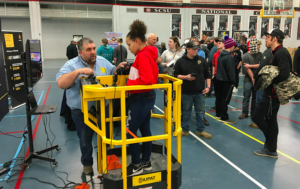Minnesota’s Construction Industry Landscape Changes with New Technologies
From computers and software to physical robots, technologies today are dramatically shifting job roles and responsibilities and disrupting all industries. But Minnesota’s construction industry has already begun adopting and integrating technologies to maximize project turnaround time, construction planning and worker safety.
“A career in construction is never stagnant and hands-on learning takes place every day,” said Sarah Lechowich senior director for the Twin Cities-based nonprofit Construction Careers Foundation, which oversees a state-wide initiative to encourage young people to consider careers in Minnesota’s construction industry called Construction Career Pathways.
“Minnesota’s construction industry is constantly growing and evolving with the application of new technologies,” Lechowich added. “Construction Career Pathways is educating middle- and high school students about the diverse skill sets and passions they can pursue through a career in construction.”

Construction Career Pathways partners with Minnesota high schools to create hands-on events that pair students with industry leaders to showcase post secondary options.
Photo Credit: Alex Svejkovsky
Through the Constructioncareers.org website, students can explore more than 30 construction careers and apprenticeship opportunities as well as connect with local union training centers to learn more about a specific trade.
Here are four new technologies that Minnesota construction professionals are using to get the job done right.
1. 3D Printing and Modeling
The precision and accuracy of 3D printing technology offers greater safety and resilience to structures and materials. So far, metals, plastic, composites and even concrete can be 3D printed to use as a model or inserted onsite into construction work. Use of 3D printing in the construction industry has helped in expediting the processes of on-site construction and offers several cost benefits to project owners and managers.
Students who get hands-on experience with 3D printing and computer programing and modeling classes in high school may have the opportunity to apply their skills to architectural construction arrangements and render blueprints in the field. Blueprint reading, being detail-oriented and visualizing how a project will appear in a space are critical skills construction workers use every day.
2. Infrared Thermography Cameras
These cameras are used to quickly spot bridge and building defects. The need for timely and accurate inspection of bridges and other structures is growing as America’s infrastructure ages. The camera’s infrared sensors can detect electromagnetic radiation and heat fluctuations that indicate areas of stress, allowing professionals to quickly target and address areas of concern. ITC cameras are relatively new to the construction industry but are predicted to be used frequently on jobsites to monitor projects and keep workers aware and safe in addition to the use of personal protective equipment (PPE).
3. Drones
Drones have a place in the future of construction as they can quickly take accurate aerial photos and videos of construction sites. Many drones today are already equipped with a variety of cameras and sensors, which can help professionals with analysis of new construction such as parking lots, power plants and evaluating the curing temperature of concrete.
“Drone and camera technologies have the ability to provide real-time visual information to professionals at any particular moment in time,” Lechowich said. “While we educate students about careers in construction, we also talk to them about how technology is intertwined with trades work because contractors, companies and training centers adopt innovations that have been developed to make construction work efficient and safer.”
4. 5G (next generation of cellular technology and connectivity)
According to Verizon, half of the U.S. will have access to 5G by the end of 2020. Successful on-site construction monitoring requires effective tracking of health, location, status and specifications of all objects and people.
5G is expected to enable better data collection and analysis in the construction industry, such as the status of site machinery, and whether it’s available for use. The advantages of 5G opens up many new possibilities for construction businesses, especially when evaluating worker safety, mitigating risks and reducing security concerns.
“Youth construction apprentices are walking onto a totally different job site then people did 20 years ago,” Lechowich said. “The adoption of technological advancements continue to bring success to Minnesota’s construction industry and keep workers safer while they get the job done.”
To learn more about careers in construction, visit Constructioncareers.org.
